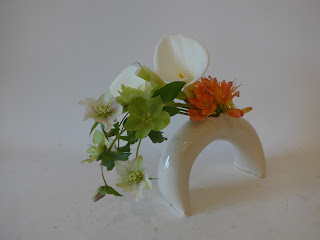 |
| Calla lilies, green goddess lilies and clivia berries |
Hello all,
Ikebana International was approached recently by a rather exclusive club in the city requesting someone to make ikebana table arrangements for a Japanese dinner they were planning. Lucy and I volunteered to do 18 table arrangements and one larger one for the entry to the dining room.
We had a number of challenges to overcome, such as to make all the arrangements low, so that they did not obstruct the guests' view. They also had to be quite narrow to fit in between the table settings. But the biggest challenge of all was how to fit all our materials and containers in one car, because we were allocated only one parking spot. This was impossible, so my ever-supportive husband loaded up his car and drove down then drove it back home.
We gave quite a lot of thought as to how to approach this exercise and decided to use this opportunity to show people, who would otherwise not know about ikebana, the scope of our work. So we planned to make completely different arrangements on each table. We used all kinds of containers ie: ceramic, glass, basket and metal. We even made miniature arrangements on two tables. We placed 5 miniatures on a black board on each table. These elicited an unexpected amount of interest. People kept stopping and peering at them intently.
 |
| This was at the entry of the dining room |
We were overwhelmed by the interest that was created even whilst we were setting up. Apart from the staff who were clearly delighted with our work, guests of the establishment kept drifting into the dining room saying they had been told to come and see what we were doing and as they left, they too were very generous with their praise.
All the photographs in this post were very kindly provided by Chieko Yazaki, the president of Ikebana International. As you can see, the tables were set up for dinner with a lot of glassware, which made it difficult to fit the arrangements on the tables and also to photograph them. As some of them did not photograph well, I am not including them here.
 |
| Mahonia leaves and red and yellow chrysanthemums |
The two arrangements, below, were placed on either end of one long table. They were made using one strelitzia nicolai flower, which was cut in half.

 |
| One strrelitzia nicolai leaf, one monstera deliciosa leaf and three cymbidium orchid stems |
 |
| Stachyurus stems, cymbidium orchids and alstroemeria leaves in a basket |
 |
| Aspidistras and cymbidium orchid |
 |
| Loquat branch with camellias |
 |
| Calla lilies in glass decanters |
 |
| Magnolia soulangeana and magnolia grandiflora leaves |
 |
| I'm sorry, I don't know the name of this succulent. |
 |
| Camellias and pine |
The following three arrangements were placed on one very long table with seating for 23 people. The two 'pond' arrangements were placed on either end with the round one in the centre.
We had so much positive feed back that it made all our efforts worth while. We are, also very grateful to the staff of the establishment for their ready help.
Bye for now,
Emily
























